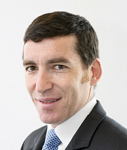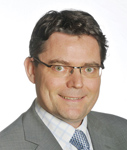
Karim El Naggar
VP Network Management

Hervé Amossé
VP Strategy & Innovation
EET&D : Sometimes it can be challenging to know where to begin these interviews… I must say, this is definitely not one of those cases. With the new ownership resulting from the sale of AREVA’s T&D business hanging in the balance for nearly a year, the recent announcement dividing ownership between two other French-owned companies – Alstom and Schneider Electric – almost seems anti-climactic at this point, especially in view of the fact that Areva had originally acquired the T&D unit from Alstom in January 2004. So far, details of the arrangement have remained few and far between, so perhaps we can start by addressing the question that seems to be on nearly everyone’s mind lately: How is the Alstom Grid business organized, and what is its mission/vision?
Amossé : Alstom Grid was launched on June 8th of this year. This new sector of Alstom is formed from the transmission activities of Areva T&D and becomes a natural third pillar, alongside Alstom Transport and Alstom Power. Alstom Grid – as the name suggests – is a specialist in the electrical grid, and in particular, we would say the Smart Grid. Its products, systems, automation and services are supplied throughout the world to utility and large industrial customers. With leadership positions in several markets and technologies, this sector comprises over 20,000 employees and has a turnover in excess of 3.5 billion Euros. Products include Power Transformers, Gas-Insulated Substations (GIS), Circuit Breakers, Instrument Transformers and Disconnectors up to 1,200kV AC. Systems include turnkey AC and DC substations, grid interconnections, advanced power electronics and special power systems for industry.
EET&D : And how does the former Areva T&D automation business fit into the new Alstom Grid?
Amossé : Grid Automation solutions range from energy market network and generation management systems to substation automation, protection and control. Moreover, the Alstom Grid Service business supports the installed base throughout the life cycle of the equipment, around the world.
EET&D : Moving on, the energy industry is in a state of flux – to use an electrical term – right now. Between Smart Grid initiatives, Stimulus Bill funding, renewables projects, clean energy legislation and a host of other changes currently taking shape, challenges abound. What do you feel are the most daunting and/or highest priority issues the industry is facing today?
El Naggar : Making the grid smarter is a game changer in the energy world. The challenge to energy utilities, vendors, suppliers – and governments around the world – is to create integrated network solutions and apply advanced computer software and communication technologies to improve the automation, protection, monitoring and control of the power grid. Simply said – a smarter grid.
EET&D : Which part of your new organization will be taking the lead on accomplishing that task?
El Naggar : Automation’s Network Management Solutions leads our Smart Grid initiatives. Over the years, we have grown our portfolio of smart network solutions for transmission and distribution grids through technology innovation.
EET&D : Technology innovation is a pretty broad term. Can you give us some examples of what you mean by that?
Amossé : Sure. PMUs – or Phasor Measurement Units – are a good place to start. PMUs send measurements to the control center at up to 60 samples per second. Sudden changes in these measurements alert a control center operator to changes in grid conditions. If a potential problem occurs, the operator is then able to locate, isolate and fix the problem quickly. The challenge is to combine fast measurements with advanced network management applications, which can execute fast controls to protect the grid in an automated manner.
EET&D : Can you briefly explain how this PMU approach is different from the traditional methods currently in use?
Amossé : This is a key departure from traditional – and far more elementary – SCADA control, which simply samples network measurement at a typical 15-minute interval, thereby missing some of the critical transient behaviors of the grid. Very often these are the only early warnings of potentially catastrophic failures, such as the one witnessed in the U.S. Northeast Blackout in August 2003.
EET&D : So, in that respect, I guess PMUs open up a whole new opportunity of on-line stability control of the grid?
Amossé : Yes, by collecting PMU data from across the grid, integrating and analyzing that data and then holistically presenting it to the operator on a single screen utilities can have a much better level of system awareness and the ability to react more quickly to potentially catastrophic events. In the United States, the Department of Energy has allocated over $200 million for deploying 700 PMUs over the next three years, in addition to the existing 200 PMUs, making this one of the most significant increases in grid intelligence we’ve seen in quite some time.
EET&D : Renewable energy resources are another hot topic these days. There has been a lot written about renewables – especially wind and solar – from an investment and development standpoint, but not so much about the integration of these resource additions into the traditional G, T & D equation. What can you tell us about how these new resources are being harnessed and integrated into the existing grid?
El Naggar : Let’s look at Wind Power, for example. The build up of large-scale wind farms definitely creates a significant challenge to transmission operators because an increasing portion of the production of electricity becomes less predictable and highly variable. New technology is needed both to help utilities forecast production more accurately and to allow the grid to cope with rapid fluctuations of generation. Renewable integration includes advanced real-time calculation and estimation techniques, ‘look ahead’ network security analysis functionalities and realistic environment simulation driven by wind production forecasts.
EET&D : Is this the sort of thing that utilities can expect to handle today, or are we talking about the future development of renewables?
El Naggar : This is happening today; it isn’t just a pie-in-the-sky concept or R&D project. We have partnered with one of the largest utilities in Europe which has the largest share of renewable energy production in Denmark. The country has more than 6,300 individual wind generators that produce more than 20% of the country’s total generation. We provided a SCADA/EMS for the Danish National Control Center including a comprehensive Wind integration component, which allows the utility to safely and efficiently operate the grid even when Wind energy peaks at 50% of the total country power generation.
EET&D : As we all know, the Stimulus Bill will provide quite a lot of funding for Smart Grid and Grid Transformation projects over the next few years. To what extent will Alstom play a role in these projects?
El Naggar : Our North American unit is deeply committed to several Stimulus initiatives. For example, we have created a task force to develop and implement smart grid solutions in line with the U.S. government’s Smart Grid Stimulus Package. To date, we have identified 70 Smart Grid Stimulus opportunities in consultation with our utility customers and submitted Smart Grid Worker Training proposals to seven universities.
Amossé : We are also participating in the Pacific Northwest Smart Grid Demonstration Project, one of the most unique and innovative Smart Grid projects currently under way. This $178 million project is one of 16 regional smart grid demonstration awards, funded in part by the American Recovery and Reinvestment Act (ARRA). The purpose of the project – managed by the prestigious Battelle Memorial Institute – will expand upon existing infrastructure and test new Smart Grid technology with up to 60,000 customers in Idaho, Montana, Oregon, Washington and Wyoming. Alstom is a technology and vendor partner on the project team.
EET&D : A substantial portion of the ARRA funding is, of course, directed toward research and development for renewable energy resources. Does your participation here in North America extend into the work you are doing in Europe that we discussed previously relative to the renewables sector?
El Naggar : Absolutely, the U.S. seeks to achieve 20 percent wind energy generation by the year 2030. A research grant from the U.S. Department of Energy for work to prepare the U.S. electrical grid for growth in wind power will help to achieve that goal. This research will focus on best practices for managing wind energy in control room operations and on the effective use of wind forecasts. Alstom will leverage its experience in Europe to develop recommendations to effectively manage this dramatically increased amount of wind power in the U.S. energy mix over the next two decades and beyond.
EET&D : It seems as though the next generation of electric power systems will be much more regional in scope and that coordination across power pool operators and constituents will be dramatically increased and improved. Can you offer any examples of this shift?
El Naggar : The Western Electricity Coordinating Council (WECC) is the regional entity responsible for daily coordination and long-range planning needed to provide reliable electric service in 14 states, Alberta, Canada and British Columbia, and the northern portion of Baja California, Mexico. Some 40 electric power systems are part of this consortium. Our solutions offer WECC a unique opportunity to tightly integrate the participants of their program and implement coordinated grid management across all 14 of the member states. And as you pointed out, this type of regional approach is expected to become increasingly prevalent in the future.
Editor’s Note: Details about reorganization of the low-voltage (“distribution”) portion of the Areva T&D business unit were unavailable at press time. Please watch the Industry News section in future issues of Electric Energy T&D Magazine and our ElectricEnergyOnline.com eNewsletter for further details about the reorganization. Also, since the time of this interview, Hervé Amossé has been appointed as Alstom Grid’s Vice President Substation Automation, in charge of the Substation Automation Solutions Product Line.







